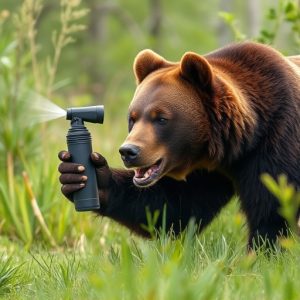Maximizing Bear Spray Protection: Ingredients, Usage, and Legal Insights
Bear spray, a vital defense tool for adventurers in bear-inhabited territories, uses capsaicin, oleo…….
Bear spray, a vital defense tool for adventurers in bear-inhabited territories, uses capsaicin, oleoresin capsicum (OC), and other chemicals like picric acid and 2-ethoxyethyl vanillate to deter bears. These ingredients irritate bears' sensitive areas, inducing a retreat response. Understanding these chemicals and proper usage techniques, including training, targetting, and expiration date checks, is key to maximizing its effectiveness as a safe yet formidable defense against wildlife attacks while navigating bear-inhabited areas, always remembering to comply with local legal frameworks and storage practices.
“Uncover the ultimate self-defense weapon in remote wilderness areas: bear spray. This powerful tool has proven its effectiveness against aggressive bears, offering a non-lethal yet potent solution for outdoor enthusiasts. In this comprehensive guide, we’ll explore the inner workings of bear spray, from its active ingredients and maximum strength capabilities to usage tips and legal aspects. Discover the essential knowledge on what chemicals are in bear spray and how to use it safely, ensuring your peace of mind while exploring nature’s wonders.”
- Understanding Bear Spray: A Brief Overview
- The Active Ingredients: What Makes It Effective?
- Maximum Strength: Unlocking Its Power
- Usage and Safety Tips for Optimal Protection
- Legal Considerations and Best Storage Practices
Understanding Bear Spray: A Brief Overview
Bear spray, also known as bear repellent, is a crucial defense weapon for individuals venturing into bear-inhabited areas. It’s designed to deter and scare bears when faced with an encounter, providing vital time for escape or retreat. Understanding what makes up this potent tool is essential for anyone planning outdoor activities in regions where bears roam.
The primary active ingredient in bear spray is a mixture of capsaicin, the compound that gives chili peppers their heat, and other chemicals like oleoresin capsicum (OC). These substances irritate a bear’s eyes, nose, and respiratory system, causing them to recoil and retreat. Modern formulations also include additional agents to enhance effectiveness and user safety, such as natural plant extracts and UV stabilizers to prevent degradation in various weather conditions. Knowing what chemicals are at play helps users appreciate the spray’s potency and proper usage techniques when facing a bear encounter.
The Active Ingredients: What Makes It Effective?
Bear spray, a powerful defense weapon, relies on specific active ingredients to achieve maximum effectiveness against aggressive bears. The primary chemical components typically include capsaicin, a substance derived from chili peppers, and various types of pepper spray. These chemicals work by causing a burning sensation in the bear’s eyes and nose, temporarily blinding and disorienting it, which allows for an escape or a chance to fight back.
The potency of bear spray lies in its ability to target the bear’s sensory system. Capsaicin irritates the eyes and respiratory tract, while pepper spray can cause inflammation and pain upon contact with skin or mucous membranes. The combination of these irritants creates a potent defense mechanism that can deter even the most aggressive bears, making it an indispensable tool for outdoor enthusiasts navigating bear-inhabited areas.
Maximum Strength: Unlocking Its Power
Bear spray, also known as bear repellent, is a powerful defense weapon designed to protect individuals from aggressive bears. The maximum strength variant takes this protection to the next level by harnessing the power of specific chemicals that create an effective barrier against wildlife attacks. Understanding what chemicals are in bear spray is crucial to unlocking its potential as a formidable self-defense mechanism.
The active ingredients in maximum strength bear spray typically include capsaicin, a compound found in chili peppers known for its ability to cause a burning sensation and temporarily disable the bear’s sense of smell and vision. In combination with other chemicals like picric acid and 2-ethoxyethyl vanillate, these components work synergistically to deter bears from charging. These chemicals are carefully formulated to ensure their effectiveness while maintaining safety for the user.
Usage and Safety Tips for Optimal Protection
When using bear spray as a defense weapon, it’s crucial to understand its active ingredients and proper application for optimal protection. Bear spray typically contains capsaicin, the same chemical found in chili peppers, along with other agents like piperidincarboxylic acid (PCA) and various aromatic oils. These chemicals create a temporary but intense irritation in the bear’s eyes, nose, and respiratory system, deterring it from approaching.
For maximum effectiveness, users should follow safety tips such as carrying the spray in an easily accessible location, ensuring proper training on its use, and understanding the recommended range (usually 20-30 feet). Always aim for the bear’s face and eyes, and never point it at anyone or anything except the intended target. Regular maintenance and checking of the spray’s expiration date are also essential to guarantee its potency when needed.
Legal Considerations and Best Storage Practices
When considering bear spray as a maximum-strength defense weapon, it’s crucial to understand the legal landscape surrounding its use and possession. Each jurisdiction has specific regulations regarding bear spray, including age restrictions, permitted areas, and conditions for carrying or possessing it. For instance, some regions may require permits or registration, while others might have seasonal limitations. Before purchasing and using bear spray, familiarize yourself with local laws to avoid any legal repercussions.
Proper storage is an integral aspect of responsible ownership. Bear spray should be kept in a secure, designated area, preferably locked away from unauthorized access. Ensure the container remains intact, undamaged, and out of reach of children or pets. Given that bear spray is designed for emergency situations, regular accessibility should be prioritized without compromising safety. Ideal storage practices include mounting the spray on a wall or using specialized hardware to ensure quick retrieval during encounters. Additionally, checking expiration dates and replacing the spray as needed is essential to maintaining its effectiveness.
Bear spray is a powerful tool for personal safety when hiking or camping in bear country. By understanding its active ingredients, such as capsaicin and various irritants, you can fully appreciate its maximum strength potential. When used correctly and stored safely, it offers an effective defense against bears. Always check local laws regarding bear spray possession and usage to ensure compliance with regulations. With proper knowledge and precautions, bear spray can be a valuable asset for outdoor enthusiasts navigating high-risk environments.


